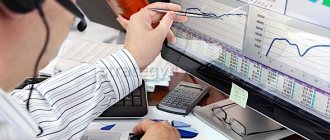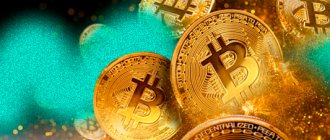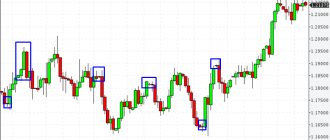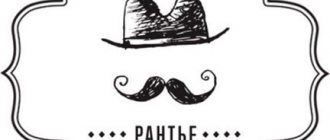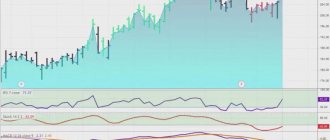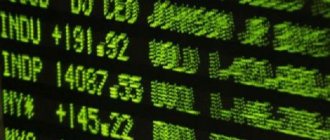What is trading
Earning money by speculating in various types of assets on financial and commodity exchanges is called trading.
Assets are currencies (rubles, dollars, pounds sterling), securities (stocks, bonds, derivatives), goods (oil, gold, grain crops, etc.).
Before becoming a trader and starting independent trading, you need to master the theory of the profession and gain initial practical skills.
Types of trading
Trading on exchange platforms is carried out in different forms, which differ:
- duration of transactions;
- ways to analyze the market situation;
- trading signals and patterns;
- technical indicators;
- methods for determining entry and exit points from a position;
- number of tools;
- risk calculation methods;
- using trading robots, etc.
Every professional speculator has a strict system according to which he carries out his transactions.
Scalping
Trading strategies that are designed for small time intervals - timeframes - are called scalping. A scalper makes from several to hundreds of transactions in 1 session - a trading day.
The trader enters the market based on trading signals that are formed on the chart or in the tape (book of exchange) in the form of indicator readings, graphic patterns, and volumes of traded contracts.
The scalper's TS determines the number of traded lots, the moment of exit from the transaction, the order of setting and the size of the stop loss - from several points.
Trading in the medium term
If a speculator holds open positions for several days or weeks, this is a medium-term strategy. Trends that have existed in the market for a relatively long time are monitored.
Traders are forced to set “stops” of 30-40 points, which requires more capital in reserve.
This trading system does not require constant presence at the monitor. On different timeframes, signals for entering the market are often similar in structure.
Both a scalper and a medium-term trader can use channels, trend lines, resistance and support levels, and the same indicators.
Long-term trading
Long-term strategies have the following advantages:
- do not require quick decisions, because trends last for months and years;
- commissions and fees are relatively small (for example, spread when concluding a transaction);
- no need to monitor the chart or feed every day (let alone every second);
- it is possible to receive dividends on shares;
- there are tax benefits;
- there is no daily stress waiting for results.
Example - paperclip strategy:
But they have a number of disadvantages:
- the investor does not immediately learn about the erroneous calculation;
- long periods of market pullbacks;
- short-term and medium-term trends are skipped without profit.
Moment
Traders who adhere to such a system enter the market at any opportune moment. They monitor all time frames and orders are placed where there is a signal.
The strategy can be considered comprehensive. Rarely used. But on our website there is a large number of such strategies and the most striking example is the graphic strategy of the BF2 website and an example of trading on it - FREE signals for every day ⇒:
Fundamental
The basis for decision-making by a speculator are fundamental indicators:
company profit;- cash flow status;
- obligations;
- quality of management;
- political situation.
The disadvantages of such strategies are:
- data inaccuracy;
- overestimation of indicators;
- unexpected events with low probability - “black swans”;
- influence of crowd psychology on price.
Technical
A specialist uses graphs and diagrams of changes in the value of an instrument to study the market. Trading can be considered technical when data obtained from such analysis is used to enter the market and close a position.
Using a mathematical apparatus, technical indicators and robotic programs are created that are capable of opening and closing transactions according to a given algorithm (semi-automatically or automatically).
Graphic patterns - “head and shoulders”, “triangle”, etc. are also figures of technical analysis.
Swing trading
Most often, a position in swing trading is held from several hours to 2-3 days. Swing trading is the use of changes (fluctuations - from swing) in the price of an asset to make a profit.
The basic principles of this strategy:
- correct entry - at the end of a rollback along a trend or on news, characterized by immediate movement of the chart in the desired direction;
- it is necessary to withstand short-term corrections;
- strict procedure for closing unprofitable transactions.
How to trade and engage in trading via the Internet, 7 stages of trading - where to start for a beginner
Stage-1: Search for a broker/dealing center
Transactions on the stock exchange are concluded through intermediaries - brokers, and in the Forex currency market - brokerage companies and dealing centers.
When choosing a company to work in the markets, you need to pay attention to the following characteristics:
- Quality of customer information support. Possibility of free training in trading from scratch, availability of seminars, courses, materials. Providing analytical reviews, news, investment consultants.
- Brokerage commission amounts.
- Presented trading terminals.
- Quality of data stream - absence of requotes, packet losses, etc.
- Types of trading accounts.
- Tools that are available for the job.
Stage-2: Opening an account, replenishing a deposit
To buy and sell through an exchange, you must have a trading account with one or more brokerage firms.
The procedure for opening a brokerage account, the minimum deposit and the list of required documents may vary depending on the company.
You need to keep in mind that in order to withdraw earned funds, the intermediary will require scans of your passport, even if they are not needed for the initial replenishment.
Stage-3: Start of opening positions
To make transactions, you will need to select an instrument - currency, shares, goods and buy or sell it. The minimum amount of an asset - lot, available for a transaction depends on the exchange and dealer.
Stage-4: Installation of trading programs
The main program in which the trader works is the terminal. They differ for different platforms and brokers.
Russian intermediaries most often use QUIK to work on the derivatives and commodity markets, and MetaTrader 4 or 5 for Forex.
Stage-5: Quote Analysis
To monitor changes in the price of an instrument, there are 2 main ways:
- studying the chart in the trading program;
- analysis of the market order book (market depth, price tables, tapes).
The developers offer hundreds of technical indicators that represent price movement in different forms.
Stage-6: Opening trading positions
Traders use the following main types of orders:
- Market - they are executed at the price available at the time the order is opened.
- Deferred - triggered when the value of the asset reaches the desired level.
Pending orders are:
- limit;
- stop (stop);
- stop-limit (stop/limit).
Step-7: Recording profit or loss
Taking Profit - taking profit when the price reaches the expected values or a specified amount of profit appears. You can close a deal manually or automatically.
To limit risk, it is customary to record losses if the market moves against the speculator. For this purpose, a Stop Loss level is set, upon crossing which the transaction will be closed.
In a good trading system, the amount of profit is greater than the amount of losses.
Section 9. Final Provisions
9.1 Any disputes related to the conclusion, amendment, execution or termination of this Agreement shall be resolved in accordance with the legislation of the Russian Federation.
9.2 The Company has the right to make changes to the terms of the Agreement by publishing a new version of the Agreement on the Website. The corresponding changes come into force from the moment the new version of the Agreement is published on the Website.
9.3 The User is obliged to periodically review the text of the Agreement in order to study the latest changes made to it. By continuing to use the Site after the relevant changes come into force, the User expresses his agreement with the terms of the Agreement in the new edition.
Choosing a Forex broker – top 3 brokerage companies
The best service on the Russian market is provided by the leaders among brokers.
To attract customers, smaller companies can offer better conditions for certain items (minimum deposit, bonus for replenishing an account, etc.). But in the complex - reliability, availability of trained specialists, number of services - leading companies will be the best choice.
Alpari
The company has existed for more than 20 years. Its services are used by about 2 million clients.
To make transactions on the Forex market, MT4, MT5 terminals and mobile applications are provided.
Investors can earn money on the foreign exchange market using PAMM accounts ⇒ .
The company provides speculators with analytics and daily market reviews. Those who wish can trade using signals from experienced traders.
Detailed information with real customer reviews - HERE ⇒
Forex4you
The company trades 150 instruments, including currencies, indices, oil, metals, cryptocurrencies, and shares of leading companies.
The broker offers 4 platforms:
- Forex4you Desktop;
- Forex4you Mobile;
- Forex4you WebTrader;
- MetaTrader 4.
The company is the leader of the trading social network Share4you.
Read more about the company + reviews from real clients of the site HERE ⇒
Roboforex
The broker guarantees the highest speed of order execution and minimum spreads - for some accounts up to 0.
You can open accounts in 6 currencies - USD, EUR, RUB, BTC, ETH, GOLD. The minimum replenishment amount is 10 euros or dollars. The maximum leverage is 1:2000. It is possible to withdraw funds without commission.
Bonuses are provided for clients - for replenishment up to 115%, cashback, profit share, CopyFx.
Similar to other companies, see reviews of this broker HERE ⇒
What tools do participants use?
The main exchange instruments with which private and qualified investors conduct transactions:
- shares – ordinary and preferred;
- bonds – state, municipal, regional, corporate, exchange-traded, foreign, commercial;
- currency;
- precious metals;
- depositary receipts;
- units of mutual funds - open, closed, interval, exchange-traded;
- ETF fund units;
- futures;
- options.
The more issuers with similar characteristics come to the exchange, the wider the choice an investor has, which is why large-cap markets always have more participants.
Types of programs, applications, services for online trading
Many IT tools have been developed to carry out online trading activities, some of which are provided by brokers free of charge.
Software for Beginners
Beginning speculators need programs that facilitate rapid learning.
One such product is Forex Tester. Using this IT tool, it is easy to test new strategies on history or in real time without risk, to see how indicators or trading robots behave in a particular market.
It is on such a tester that we test all the strategies of this site and here they are ALL - the results of testing trading systems ⇒
Applications for beginners have built-in services for learning the principles of the exchange, terminology, and demonstrating transactions of experienced specialists.
For professionals
A professional trading program performs the following functions:
- provides access to transactions with different instruments;
- organizes and displays collected data;
- implements elements of technical market analysis.
Such applications include trading and analytical programs: ATAS, Quik, MetaTrader 4/5, which are capable of making an in-depth analysis of the situation for the selected instrument and providing information to the user in an intuitive way.
For automated trading
With the development of computer technology, software has appeared that can work without human intervention - trading robots for automatic trading.
First of all, we recommend the Crazy Lock advisor ⇒
And the second one - 10 pips + martingail ⇒
Advantages of automatic IT tools:
- absence of an emotional component that interferes with market analysis;
- the ability to trade around the clock;
- the operation is performed at high speed.
But such programs are not capable of analyzing fundamental data; their work is affected by viruses and electronic failures.
